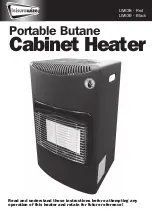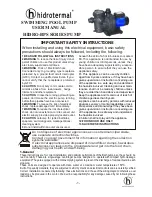
26
Revision Date: 02/07/2020
Revision: C
Pre-Assembled Rhino - Installation Manual
Appendix 9: Connecting the Supply and Return Lines
from the Roof to Ground Level
While these steps are useful, they cannot possibly cover every type of installation. Therefore, the installer may
need to get creative and adapt these steps to suit unique roof designs or unusual equipment pad locations.
Before beginning, it is important to note that:
•
Thermal expansion and contraction of all pipe work and Solar
Panels and their interconnection should be allowed for.
•
Return pipes should be the shortest and most direct run
•
Aesthetically, the supply and return pipes should be kept as close
to the gutters, valleys and ridges as possible
•
Plumbing skills and knowledge will be required, particularly when
installing over hips or valleys
•
The use of plumbing fittings should be kept to a minimum
•
Where possible 2 x 45° elbows should be used instead of 90°
elbows for less water flow restriction
•
All pipes should have a slight “downhill” slope to aid in automatic drain down
•
If any part of the system is unable to automatically drain, manual draining must be done prior to
potential freezing conditions, winterizing.
•
If needed, pipework must be secured with additional Plumbing Clamps as the systems manual
hardware is not designed to support the additional weight of the plumbing
•
The four corners of each solar array should be supported with its Roof Mounts positioned as close as
possible whilst allowing for thermal movements.
Step 1:
If not already installed, cement a PVC 90° elbow and a short length of 40mm PVC pressure pipe to the
CPVC coupling mounted to the return outlet of the array using a high quality, all-purpose primer and
cement. This elbow should face down towards the bottom header.
Step 2:
Moving to the Supply line, cement a PVC 90° elbow and a suitable length of 40mm PVC pressure pipe
to the CPVC coupling mounted on the rubber Flexible Coupling with the 90° elbow facing down away
from the system, refer Figure 1.
Step 3
: Identify where the Supply and Return pipes will go over the edge of the roof and mark this spot with
chalk. If possible, these pipes should be installed at the exact points where they will fasten into the
existing system or into pipes coming from another location.
Step 4:
Accurately measure and record the distance from the Supply and Return elbows to the marked
points. Ensure that you include the depth of the elbow socket in your measurements.
Step 5:
Cut your PVC pipes to suit the measured lengths. Clean and deburr the pipes and prime and cement
into the elbows.
Step 6:
If you are not experienced in plumbing PVC pipe, it is a good idea to lay out and connect the pipes and
fittings before cementing them. This allows you to identify and fix any potential errors.
Step 7:
Examine the system and ensure the pipes are as short, straight, and tight to the building as possible.
Once you are satisfied, go back and cement all fitting and pipework. Ensure you double check that all
parts have been properly cemented.
Step 8:
Adequately secure all pipe work whilst allowing for thermal movement with the appropriate pipe
clamps, bolts or screws with adequate silicone sealant.
Figure 1
















































